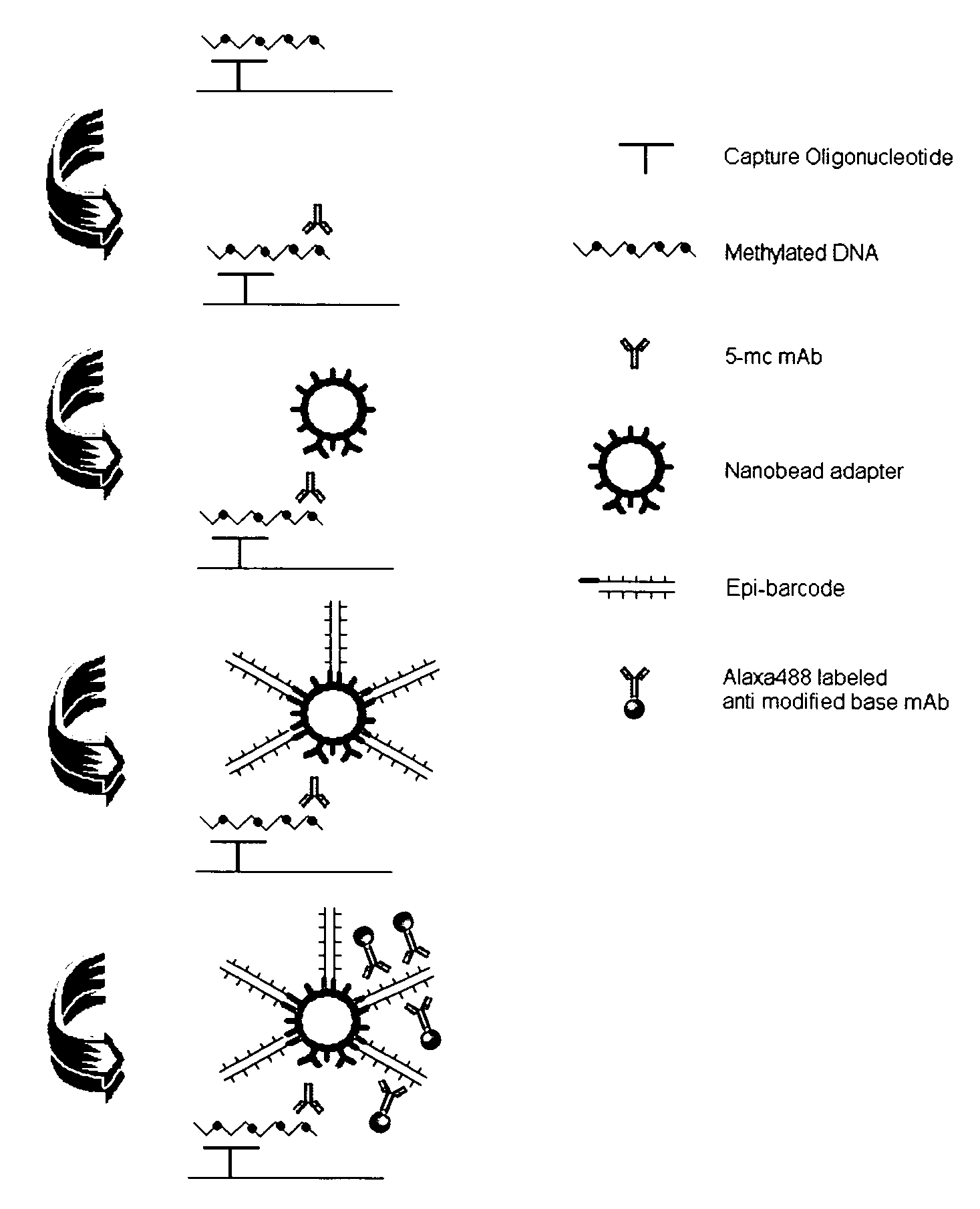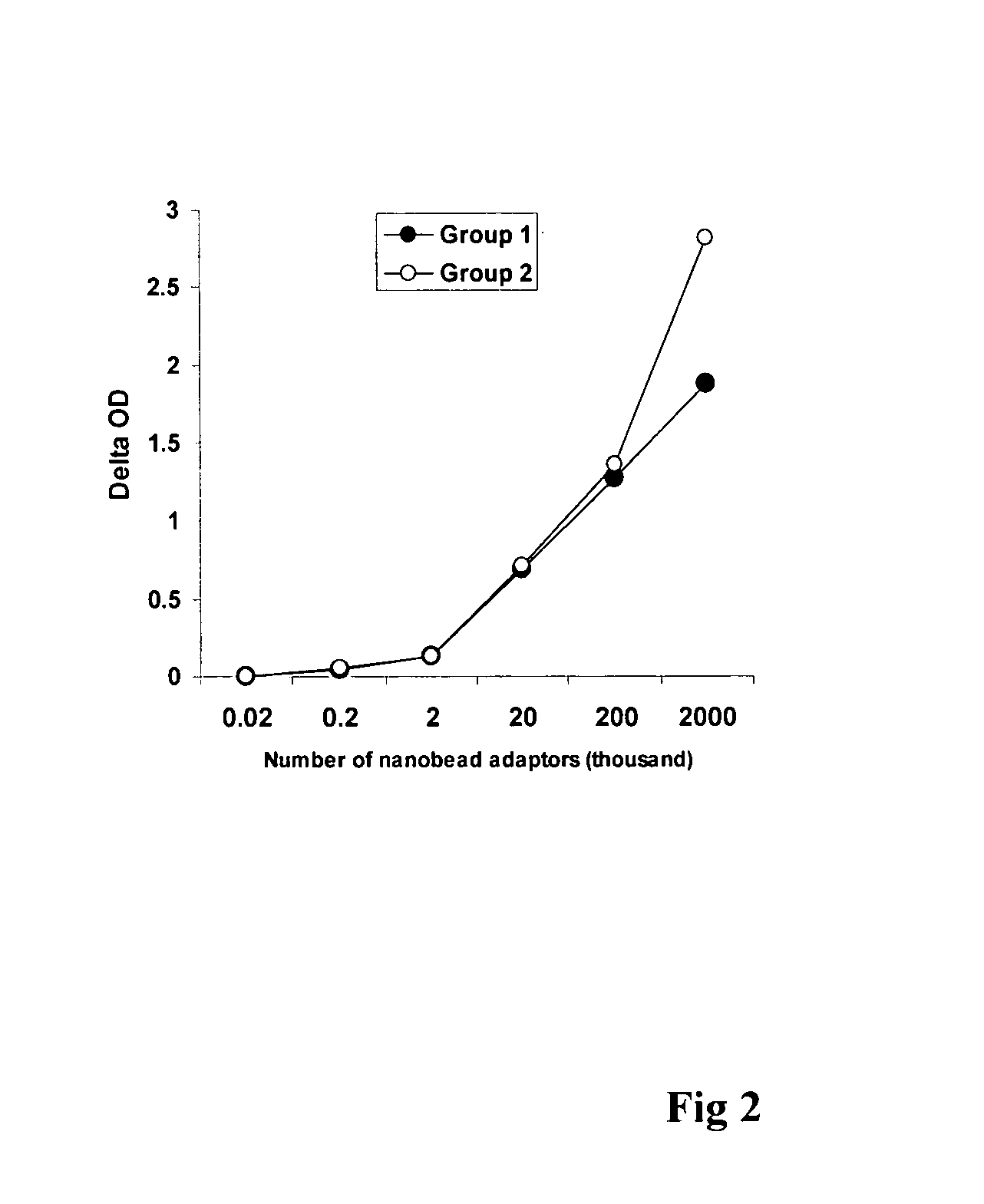DNA methylation specific signal amplification
a methylation specific and signal technology, applied in the direction of microorganism testing/measurement, biochemistry apparatus and processes, etc., can solve the problems of inhibiting the amplification reaction, laborious methods, time-consuming, etc., and achieve the effect of rapid detection of the methylated dna sequen
- Summary
- Abstract
- Description
- Claims
- Application Information
AI Technical Summary
Benefits of technology
Problems solved by technology
Method used
Image
Examples
example 1
[0037]The experiment was carried out to test the stability and the efficiency of the nanobead adaptor binding to capture antibody.
[0038]1. Preparation of nanobead adaptor. The nanobead size and type are selected based on that the specific binding of the beads to the target should be stable and tight with minimal non-specific background, while the surface area of the beads should be as large as possible for maximally conjugating bridge antibody and holder oligonucleotides. The streptavidin-coated magnetic beads in a diameter of 200 nm were found to be the most appropriate. To prepare the functionalized nanobead adaptor, 1 mg of the beads (approximately 1×1010 beads) is washed twice with PBS and resuspended in the 1 ml of PBS. 20 μl (10 pg / ml) of biotin-labeled anti-mouse IgG, as bridge antibody and 20 μl (50 pmol / μl) of 5-biotin-labeled oligo (dT)25 as holder oligonucleotides are added into the suspended beads solution, respectively. The mixed solution is incubated at room temperatur...
example 2
[0040]The experiment was carried out to test signal amplification capacity of epi-barcode.
[0041]1. Preparation of epi-barcode. Poly (dI-dC).(dI-dC) in a length of 7000 base pairs was treated with the mixed DNA methylases consisted of MSss.I and Dnmt 1 for 16 h. to allow every cytosine contained in Poly (dI-dC).(dI-dC) to be methylated. The methylated poly (dI-dC).(dI-dC) or poly (dI-MdC).(dI-MdC) is then tailed in the 3′-terminal with poly (dA) through using terminal deoxynucleotidyl transferase-based DNA tailing method.
[0042]2. Testing signal amplification capacity of epi-barcode. The aminated oligo (dT) 25 in different amounts (0.01 pg-1000 pg) were coupled to the NOS-DNA Bind stripwells. The poly dA-tailed epi-barcodes were applied to the wells followed by adding 5-MC mAb and then anti-mouse IgG-HRP. Meanwhile, the biotin-labeled oligo (dA) was also added into the wells followed by adding anti-biotin antibody conjugated with HRP. The color development was carried out and OD value...
example 3
[0043]The experiment was carried out in two groups to detect the sensitivity of the method of this invention in quantifying methylated DNA sequences. In group 1, 5 μM of a 50 mer aminated capture oligonucleotides complementary to the 40 mer methylated oligonucleotides containing 6 methylated CpGs were immobilized on the NOS-DNA Bind microplate wells. The methylated oligonucleotides were diluted to 0.1 fg-10 ng / ml and 100 μl of the methylated oligonucleotides were then hybridized to the 50 mer capture oligonucleotides at 46° C. for 0.5-1 h. After washing with 0.2×SSC containing 0.1% tween-20, 50 μl of mouse monoclonal 5-methylcytidine antibody at 1 pg / ml was added and the wells were incubated at room temperature for 1 h. After washing with PBS-tween 20, 100 μl of nanobead adaptor solution (1,000,000 beads / ml) was added and the wells were incubated at room temperature for 30 min. 50 μl of epi-barcode (400 ng / ml) was then added into the wells after washing with PBS-tween 20 solution an...
PUM
| Property | Measurement | Unit |
|---|---|---|
| size | aaaaa | aaaaa |
| time | aaaaa | aaaaa |
| diameter | aaaaa | aaaaa |
Abstract
Description
Claims
Application Information
 Login to View More
Login to View More - R&D
- Intellectual Property
- Life Sciences
- Materials
- Tech Scout
- Unparalleled Data Quality
- Higher Quality Content
- 60% Fewer Hallucinations
Browse by: Latest US Patents, China's latest patents, Technical Efficacy Thesaurus, Application Domain, Technology Topic, Popular Technical Reports.
© 2025 PatSnap. All rights reserved.Legal|Privacy policy|Modern Slavery Act Transparency Statement|Sitemap|About US| Contact US: help@patsnap.com



